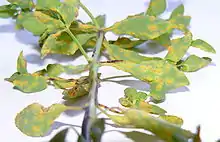Uromyces pisi-sativi
Uromyces pisi-sativi is a fungal species and plant pathogen. It was originally found on Pea (Pisum sativum) but it is found on a wide range of host plants.[3]
| Uromyces pisi-sativi | |
|---|---|
 | |
| Uromyces pisi-sativi on leaves of cypress spurge (Euphorbia cyparissias) | |
| Scientific classification | |
| Domain: | Eukaryota |
| Kingdom: | Fungi |
| Division: | Basidiomycota |
| Class: | Pucciniomycetes |
| Order: | Pucciniales |
| Family: | Pucciniaceae |
| Genus: | Uromyces |
| Species: | U. pisi-sativi |
| Binomial name | |
| Uromyces pisi-sativi (Pers.) Liro, 1908[1] | |
| Synonyms[2] | |
|
List
| |
It causes small orange dots on the lower side of leaves on Euphorbia cyparissias. It lives on Pisum and on Lathyrus and on other plants from the family Fabaceae. The list of hosts also includes; Cytisus scoparius, Chamaecytisus palmensis and Lupinus polyphyllus.[4]
Distribution
It has been recorded as being found almost worldwide; from Africa (within the Canary Islands, Ethiopia, Libya and Morocco); from Asia (within China, India, Iran, Pakistan and Turkey); from Europe (within Austria, Belgium, Bulgaria, Corsica, Cyprus, Czechoslovakia, Denmark, Finland, France, Germany, Great Britain, Greece, Hungary, Italy, Malta, Netherlands, Norway, Poland, Portugal, Romania, Sicily, Spain, Sweden, Switzerland, U.S.S.R. and Yugoslavia); from South America (Argentina and Chile) (CMI Map 404 and Herb. IMI).[5] Also Australia and New Zealand.[3]
References
- (Pers.) Liro, Bidr. Känn. Finl. Nat. Folk 65: 100 (1908)
- "Species Fungorum - GSD Species". www.speciesfungorum.org. Retrieved 26 August 2023.
- "Uromyces pisi-sativi (Pers.) Liro 1908 - Biota of NZ". biotanz.landcareresearch.co.nz. Retrieved 26 August 2023.
- Gautam, Ajay Kumar; Avasthi, Shubhi; Verma, Rajnish Kumar; Sushma; Niranjan, Mekala; Devadatha, Bandarupalli; Jayawardena, Ruvishika S.; Suwannarach, Nakarin; Karunarathna, Samantha C. (June 2022). "A Global Overview of Diversity and Phylogeny of the Rust Genus Uromyces June 2022". Journal of Fungi. 8 (6): 633. doi:10.3390/jof8060633.
- "Uromyces pisi-sativi (Pers.) Liro". www.gbif.org. Retrieved 26 August 2023.